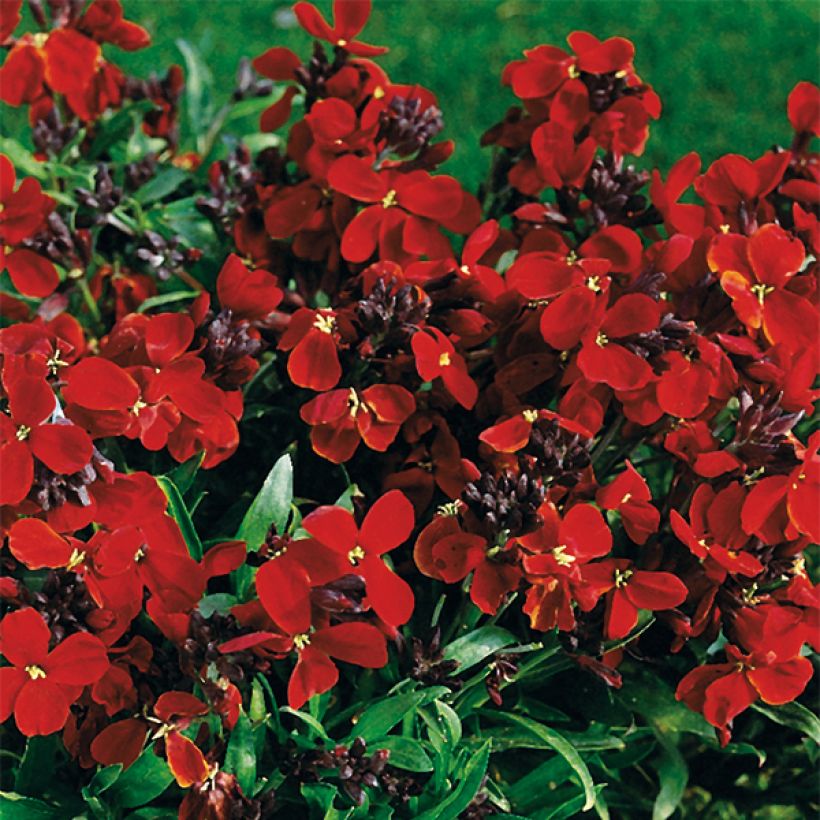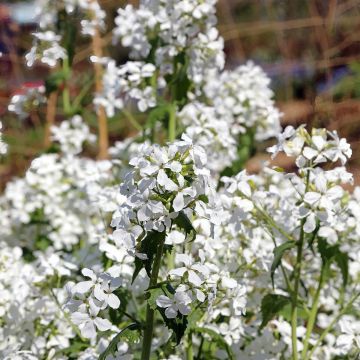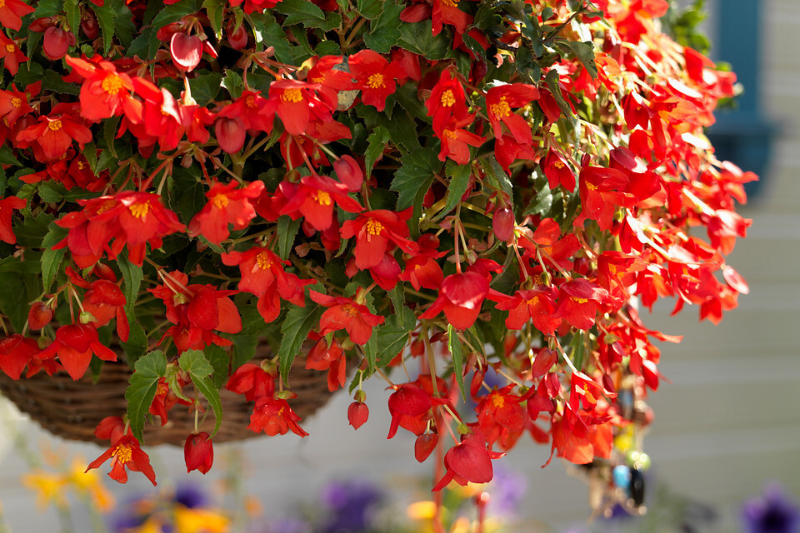

Giroflée ravenelle Bedder Vulcan brune
Erysimum Bedder Vulcan - Wallflower
Erysimum x cheiri Bedder Vulcan brune
Wallflower, Perennial Wallflower
Received mini plugs in good condition, good quality. Placed them in water in buckets, they thrived well and will be ready to be planted in the flower beds around 1st October, thank you very much.
pascal, 20/09/2024
Special offer!
Receive a €20 voucher for any order over €90 (excluding delivery costs, credit notes, and plastic-free options)!
1- Add your favorite plants to your cart.
2- Once you have reached €90, confirm your order (you can even choose the delivery date!).
3- As soon as your order is shipped, you will receive an email containing your voucher code, valid for 3 months (90 days).
Your voucher is unique and can only be used once, for any order with a minimum value of €20, excluding delivery costs.
Can be combined with other current offers, non-divisible and non-refundable.
Home or relay delivery (depending on size and destination)
Schedule delivery date,
and select date in basket
This plant carries a 6 months recovery warranty
More information
We guarantee the quality of our plants for a full growing cycle, and will replace at our expense any plant that fails to recover under normal climatic and planting conditions.
Would this plant suit my garden?
Set up your Plantfit profile →
Description
Like all the varieties in the Bedder series, Erysimum Bedder Vulcan Brown is a semi-dwarf plant with vibrant flowers, perfect for brightening up the pastel hues of spring. It is adorned with large, fragrant flowers in a velvety reddish-brown to purple colour, gathered in dense spikes. The flowering lasts 2 to 3 months, from March to May, sometimes starting in February in mild climates. It will work wonders in sunny borders, rockeries, or on banks. It can even be grown in pots on a balcony or patio. This biennial plant is actually a short-lived perennial. It is not very hardy, but it is easy to grow in the sun, in well-drained soil. It will even grow in poor and chalky soil.
Erysimum cheiri, also known as Cheiranthus cheiri, belongs to the Brassicaceae family. It is native to southern Europe, and is perfectly adapted to dry and chalky soils. This short-lived perennial is not very hardy. It is most often cultivated as a biennial or annual.
This variety is part of a horticultural series selected for its compact and branching habit, and its long multicoloured spring flowering. It quickly forms upright, bushy and compact clumps, with woody bases, covered with lanceolate leaves that are shaped like swords. The foliage is brownish-purple to bronze, with a satin-like appearance. Flowering begins in March and extends until the beginning of summer. In mild climates, and provided that it is cut back at the end of the season, this plant will show itself to be perennial (short-lived) and will even flower in winter. The 4-petalled flowers, 5 to 6cm (2in) wide, are fragrant in hot weather. They are gathered in racemes at the top of leafy stems 35cm (14in) tall. They are popular with pollinating insects that find one of the first nectars of spring at the bottom of their corollas.
Appreciated in gardens for its ease of cultivation and its tendency to self-seed in the most unlikely places, wallflowers and their cultivars are excellent rock garden plants, which thrive even in somewhat difficult soils. They also work well within walls. These plants work wonders in the border of a flower bed, in the company of love-in-a-mist, Californian poppies, and perennial flax, or in a bed with taller plants like toadflaxes, mulleins, or gauras, which are just as undemanding. It can also be placed in a pot on a patio or balcony, or near a doorway, to fully enjoy its generous flowering.
Please be aware that our young plug plants are professional products reserved for experienced gardeners. Upon receipt, transplant them as soon as possible in pots and containers, or directly in flower beds.
Report an error about the product description
Erysimum Bedder Vulcan - Wallflower in pictures






Flowering
Foliage
Plant habit
Botanical data
Erysimum
x cheiri
Bedder Vulcan brune
Brassicaceae
Wallflower, Perennial Wallflower
Cultivar or hybrid
Other Biennials A to Z
View all →Planting and care
Plant in early autumn, in a very sunny location. The soil should be well-worked and well-drained. If necessary, coarse sand or gravel can be incorporated into the planting mix. These plants tolerate limestone and occasionally dry soils, but they fear waterlogged soils in winter. For container cultivation, a mixture of ordinary soil, leaf compost, and sand or gravel should be prepared, without forgetting the drainage at the bottom of the pot (pot shards, small stones). Water regularly but without excess. Remove faded flowers to encourage new blooms.
The plant can be pruned at the end of the season, leaving only portions of stems with 3 or 4 leaves. In mild climates, or if the winter is not too harsh, it will regrow in spring. It will need to be replaced after 3 or 4 years.
Planting period
Intended location
Care
Planting & care advice
-
, onOrder confirmed
Reply from on Promesse de fleurs
Similar products
Haven't found what you were looking for?
Hardiness is the lowest winter temperature a plant can endure without suffering serious damage or even dying. However, hardiness is affected by location (a sheltered area, such as a patio), protection (winter cover) and soil type (hardiness is improved by well-drained soil).

Photo Sharing Terms & Conditions
In order to encourage gardeners to interact and share their experiences, Promesse de fleurs offers various media enabling content to be uploaded onto its Site - in particular via the ‘Photo sharing’ module.
The User agrees to refrain from:
- Posting any content that is illegal, prejudicial, insulting, racist, inciteful to hatred, revisionist, contrary to public decency, that infringes on privacy or on the privacy rights of third parties, in particular the publicity rights of persons and goods, intellectual property rights, or the right to privacy.
- Submitting content on behalf of a third party;
- Impersonate the identity of a third party and/or publish any personal information about a third party;
In general, the User undertakes to refrain from any unethical behaviour.
All Content (in particular text, comments, files, images, photos, videos, creative works, etc.), which may be subject to property or intellectual property rights, image or other private rights, shall remain the property of the User, subject to the limited rights granted by the terms of the licence granted by Promesse de fleurs as stated below. Users are at liberty to publish or not to publish such Content on the Site, notably via the ‘Photo Sharing’ facility, and accept that this Content shall be made public and freely accessible, notably on the Internet.
Users further acknowledge, undertake to have ,and guarantee that they hold all necessary rights and permissions to publish such material on the Site, in particular with regard to the legislation in force pertaining to any privacy, property, intellectual property, image, or contractual rights, or rights of any other nature. By publishing such Content on the Site, Users acknowledge accepting full liability as publishers of the Content within the meaning of the law, and grant Promesse de fleurs, free of charge, an inclusive, worldwide licence for the said Content for the entire duration of its publication, including all reproduction, representation, up/downloading, displaying, performing, transmission, and storage rights.
Users also grant permission for their name to be linked to the Content and accept that this link may not always be made available.
By engaging in posting material, Users consent to their Content becoming automatically accessible on the Internet, in particular on other sites and/or blogs and/or web pages of the Promesse de fleurs site, including in particular social pages and the Promesse de fleurs catalogue.
Users may secure the removal of entrusted content free of charge by issuing a simple request via our contact form.
The flowering period indicated on our website applies to countries and regions located in USDA zone 8 (France, the United Kingdom, Ireland, the Netherlands, etc.)
It will vary according to where you live:
- In zones 9 to 10 (Italy, Spain, Greece, etc.), flowering will occur about 2 to 4 weeks earlier.
- In zones 6 to 7 (Germany, Poland, Slovenia, and lower mountainous regions), flowering will be delayed by 2 to 3 weeks.
- In zone 5 (Central Europe, Scandinavia), blooming will be delayed by 3 to 5 weeks.
In temperate climates, pruning of spring-flowering shrubs (forsythia, spireas, etc.) should be done just after flowering.
Pruning of summer-flowering shrubs (Indian Lilac, Perovskia, etc.) can be done in winter or spring.
In cold regions as well as with frost-sensitive plants, avoid pruning too early when severe frosts may still occur.
The planting period indicated on our website applies to countries and regions located in USDA zone 8 (France, United Kingdom, Ireland, Netherlands).
It will vary according to where you live:
- In Mediterranean zones (Marseille, Madrid, Milan, etc.), autumn and winter are the best planting periods.
- In continental zones (Strasbourg, Munich, Vienna, etc.), delay planting by 2 to 3 weeks in spring and bring it forward by 2 to 4 weeks in autumn.
- In mountainous regions (the Alps, Pyrenees, Carpathians, etc.), it is best to plant in late spring (May-June) or late summer (August-September).
The harvesting period indicated on our website applies to countries and regions in USDA zone 8 (France, England, Ireland, the Netherlands).
In colder areas (Scandinavia, Poland, Austria...) fruit and vegetable harvests are likely to be delayed by 3-4 weeks.
In warmer areas (Italy, Spain, Greece, etc.), harvesting will probably take place earlier, depending on weather conditions.
The sowing periods indicated on our website apply to countries and regions within USDA Zone 8 (France, UK, Ireland, Netherlands).
In colder areas (Scandinavia, Poland, Austria...), delay any outdoor sowing by 3-4 weeks, or sow under glass.
In warmer climes (Italy, Spain, Greece, etc.), bring outdoor sowing forward by a few weeks.























































